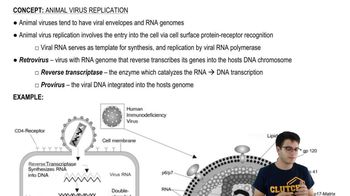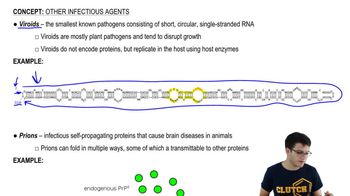Table of contents
- 1. Introduction to Biology2h 42m
- 2. Chemistry3h 40m
- 3. Water1h 26m
- 4. Biomolecules2h 23m
- 5. Cell Components2h 26m
- 6. The Membrane2h 31m
- 7. Energy and Metabolism2h 0m
- 8. Respiration2h 40m
- 9. Photosynthesis2h 49m
- 10. Cell Signaling59m
- 11. Cell Division2h 47m
- 12. Meiosis2h 0m
- 13. Mendelian Genetics4h 44m
- Introduction to Mendel's Experiments7m
- Genotype vs. Phenotype17m
- Punnett Squares13m
- Mendel's Experiments26m
- Mendel's Laws18m
- Monohybrid Crosses19m
- Test Crosses14m
- Dihybrid Crosses20m
- Punnett Square Probability26m
- Incomplete Dominance vs. Codominance20m
- Epistasis7m
- Non-Mendelian Genetics12m
- Pedigrees6m
- Autosomal Inheritance21m
- Sex-Linked Inheritance43m
- X-Inactivation9m
- 14. DNA Synthesis2h 27m
- 15. Gene Expression3h 20m
- 16. Regulation of Expression3h 31m
- Introduction to Regulation of Gene Expression13m
- Prokaryotic Gene Regulation via Operons27m
- The Lac Operon21m
- Glucose's Impact on Lac Operon25m
- The Trp Operon20m
- Review of the Lac Operon & Trp Operon11m
- Introduction to Eukaryotic Gene Regulation9m
- Eukaryotic Chromatin Modifications16m
- Eukaryotic Transcriptional Control22m
- Eukaryotic Post-Transcriptional Regulation28m
- Eukaryotic Post-Translational Regulation13m
- 17. Viruses37m
- 18. Biotechnology2h 58m
- 19. Genomics17m
- 20. Development1h 5m
- 21. Evolution3h 1m
- 22. Evolution of Populations3h 52m
- 23. Speciation1h 37m
- 24. History of Life on Earth2h 6m
- 25. Phylogeny2h 31m
- 26. Prokaryotes4h 59m
- 27. Protists1h 12m
- 28. Plants1h 22m
- 29. Fungi36m
- 30. Overview of Animals34m
- 31. Invertebrates1h 2m
- 32. Vertebrates50m
- 33. Plant Anatomy1h 3m
- 34. Vascular Plant Transport1h 2m
- 35. Soil37m
- 36. Plant Reproduction47m
- 37. Plant Sensation and Response1h 9m
- 38. Animal Form and Function1h 19m
- 39. Digestive System1h 10m
- 40. Circulatory System1h 57m
- 41. Immune System1h 12m
- 42. Osmoregulation and Excretion50m
- 43. Endocrine System1h 4m
- 44. Animal Reproduction1h 2m
- 45. Nervous System1h 55m
- 46. Sensory Systems46m
- 47. Muscle Systems23m
- 48. Ecology3h 11m
- Introduction to Ecology20m
- Biogeography14m
- Earth's Climate Patterns50m
- Introduction to Terrestrial Biomes10m
- Terrestrial Biomes: Near Equator13m
- Terrestrial Biomes: Temperate Regions10m
- Terrestrial Biomes: Northern Regions15m
- Introduction to Aquatic Biomes27m
- Freshwater Aquatic Biomes14m
- Marine Aquatic Biomes13m
- 49. Animal Behavior28m
- 50. Population Ecology3h 41m
- Introduction to Population Ecology28m
- Population Sampling Methods23m
- Life History12m
- Population Demography17m
- Factors Limiting Population Growth14m
- Introduction to Population Growth Models22m
- Linear Population Growth6m
- Exponential Population Growth29m
- Logistic Population Growth32m
- r/K Selection10m
- The Human Population22m
- 51. Community Ecology2h 46m
- Introduction to Community Ecology2m
- Introduction to Community Interactions9m
- Community Interactions: Competition (-/-)38m
- Community Interactions: Exploitation (+/-)23m
- Community Interactions: Mutualism (+/+) & Commensalism (+/0)9m
- Community Structure35m
- Community Dynamics26m
- Geographic Impact on Communities21m
- 52. Ecosystems2h 36m
- 53. Conservation Biology24m
17. Viruses
Viruses
Problem 3`
Textbook Question
In the viral replicative cycle, what reaction do viral proteases catalyze?
Select True or False for each statement.
T/F They catalyze polymerization of amino acids into peptides.
T/F They catalyze folding of long peptide chains into functional proteins.
T/F They catalyze cutting of polyprotein chains into functional proteins.
T/F They catalyze breaking of peptide bonds
 Verified step by step guidance
Verified step by step guidance1
Understand the role of viral proteases: Viral proteases are enzymes that play a crucial role in the viral replicative cycle by processing viral polyproteins into functional proteins.
Examine the statement about polymerization: Viral proteases do not catalyze the polymerization of amino acids into peptides. This process is typically carried out by ribosomes during translation.
Consider the statement about folding: Folding of proteins into their functional forms is generally facilitated by chaperones, not proteases. Proteases are involved in cleaving peptide bonds.
Analyze the statement about cutting polyprotein chains: Viral proteases catalyze the cleavage of polyprotein chains into individual functional proteins, which is essential for viral maturation and replication.
Evaluate the statement about breaking peptide bonds: Viral proteases indeed catalyze the breaking of peptide bonds, specifically within polyprotein chains, to produce functional viral proteins.
 Verified video answer for a similar problem:
Verified video answer for a similar problem:This video solution was recommended by our tutors as helpful for the problem above
Video duration:
51sPlay a video:
Was this helpful?
Key Concepts
Here are the essential concepts you must grasp in order to answer the question correctly.
Viral Proteases
Viral proteases are enzymes that play a crucial role in the viral life cycle by processing viral polyproteins into functional proteins. They achieve this by cleaving specific peptide bonds within the polyprotein, allowing the virus to mature and become infectious. Understanding their function is essential for comprehending how viruses replicate and how antiviral drugs can target these enzymes.
Recommended video:
Guided course

Viral Genetics
Polyprotein Processing
Polyprotein processing is a mechanism used by many viruses where a single, long polyprotein is synthesized and then cleaved into multiple functional proteins by viral proteases. This process is vital for the virus as it allows the production of various proteins from a single mRNA transcript, facilitating efficient use of the host's resources and ensuring proper viral assembly and replication.
Recommended video:
Guided course

1) RNA Processing
Peptide Bond Cleavage
Peptide bond cleavage is the biochemical reaction catalyzed by proteases, including viral proteases, where the peptide bonds between amino acids in a protein or polyprotein are broken. This reaction is essential for converting inactive polyproteins into active, functional proteins, which are necessary for the virus to replicate and assemble new viral particles.
Recommended video:
Guided course

Hydrogen Bonding
Related Videos
Related Practice
































































![Plaque Assay: Assay for estimating viral titre or viral concentration [plaque forming units / mL]](https://img.youtube.com/vi/zFqyaoLQbxQ/mqdefault.jpg)
































